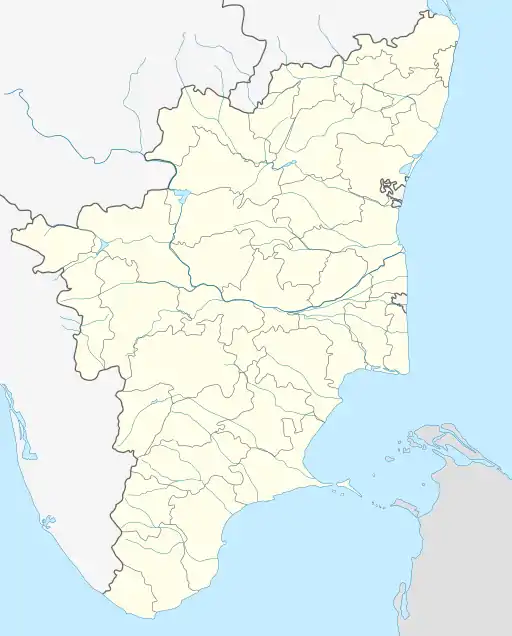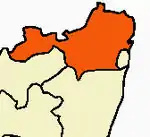Poonamallee
Poonamallee (Tamil: [puːʋiɾɯn̪daʋalli]) (historically Poovirundhavalli) is a neighbourhood in the west of Chennai, India. It is a town in the Poonamallee taluk of the Tiruvallur district in the Indian state of Tamil Nadu. The nearest Railway station is at Thiruninravur. It acts as the gateway to the city from its western side. It is a town with rich cultural heritage and also a fast-growing areas in the city. As of 2011, the town had a population of 57,224. There are plans to merge the areas under Poonamallee Municipality with Avadi Municipal Corporation.
Poonamallee
Poovirundhavalli | |
|---|---|
Neighbourhood | |
 An aerial view of Poovirundhavalli | |
| Nickname(s): Poovai | |
 Poonamallee Poovirundhavalli(Chennai)  Poonamallee Poonamallee (Tamil Nadu)  Poonamallee Poonamallee (India) | |
| Coordinates: 13.05°N 80.11°E | |
| Country | India |
| State | Tamil Nadu |
| Metro | Chennai |
| Government | |
| • Type | Municipality |
| • Body | Municipality |
| Area | |
| • Total | 13.65 km2 (5.27 sq mi) |
| Elevation | 25 m (82 ft) |
| Population (2011) | |
| • Total | 57,224 |
| • Density | 4,200/km2 (11,000/sq mi) |
| Languages | |
| • Official | Tamil |
| Time zone | UTC+5:30 (IST) |
| PIN | 600 056 |
| Telephone code | 044 |
| Vehicle registration | TN 12 (RTO, Poovirundhavalli) |
Location
The town of Poonamallee is situated at a distance of 23 km from Fort St George and 17 km from Sriperumbudur on the Chennai-Bangalore highway and 12 km from Thiruninravur on Chennai Outer Ring Road. It is located at the end of the Mount-Poonamallee Road, Poonamalle High Road and Pallavaram-Kundrathur-Poonamallee Road, 11 km from Guindy and 13 km from Chennai Mofussil Bus Terminus on the Chennai bypass. The nearest railway station is at Avadi and Thiruninravur which is nine km away and Pallavaram Railway Station on the South Line of the Chennai Suburban Railway which is 12 km away. It is also an important halting point for buses starting from Chennai Mofussil Bus Terminus and going towards Tirupati, Kanchipuram, Vellore etc.
Etymology
The name "Poonamallee" might have been derived from "Poovirundavalli", meaning "the place where jasmine is cultivated". There is a legend that Goddess Laxmi rose from jasmine flower and gave darashan to Thirukatchi Nambi Alwar. It is also said the Alwar worshipped God Varadaraja, deity at Kanchi with the jasmine flowers plucked from here. This place is also called "Lakshmipuram" and Ulagu Vuyya Konda Cholapuram.
Places of interest
Poonamallee is believed to be the birthplace of Thirukatchi Nambigal, a staunch devotee of Varadaraja Perumal. Thirukatchi Nambigal was one of the gurus for Acharya Ramanujar. He advised Ramanuja to visit Thirukoshtiyur and learn the 'Sacred 8 letter hymn' - Ashtakshara manthra from Thirukoshtiyur Nambigal at Sowmya Narayana Perumal temple. There is an ancient temple for lord Varadaraja Perumal with his consort, Pushpakavalli Thayar at Poonamallee. It is also known as Arulaperumal.
There is also another temple, a medium-sized one, here for Lord Vaidyanathaswami with His Consort Thaiyal Nayagi. He is known as Theera Vinai Theertha Perumal. Poonamallee is famous for its Siva temple which has three inscriptions dating to the 18th century AD.[1] there are three Old Traditional C churches and a mosque was built and completed by Rustom, son of Dhulfiquer of Astrabad, a servant of Nawab Jumlat-ul-mulk. A Persian inscription dated 1653 AD, found in the mosque reveals this information." There is also a Muhammedan fort nearby.[1] There is also old cemetery in Poonamallee, which is the resting place of many British missionaries. The bus stop next to the cemetery says Kallarai, which is the Tamil word for cemetery.
Demographics
| Year | Pop. | ±% |
|---|---|---|
| 1881 | 7,670 | — |
| 1901 | 15,323 | +99.8% |
| 1911 | 16,342 | +6.7% |
| 1921 | 17,549 | +7.4% |
| 1931 | 20,340 | +15.9% |
| 1941 | 18,704 | −8.0% |
| 1951 | 20,677 | +10.5% |
| 1981 | 23,667 | +14.5% |
| 1991 | 28,827 | +21.8% |
| 2001 | 42,604 | +47.8% |
| 2011 | 57,224 | +34.3% |
Sources:
| ||
According to 2011 census, Poonamallee had a population of 57,224 with a sex-ratio of 999 females for every 1,000 males, much above the national average of 929.[3] A total of 6,496 were under the age of six, constituting 3,313 males and 3,183 females. Scheduled Castes and Scheduled Tribes accounted for 15.24% and 0.1% of the population respectively. The average literacy of the town was 78.88%, compared to the national average of 72.99%.[3] The town had a total of 14668 households. There were a total of 22,411 workers, comprising 133 cultivators, 226 main agricultural labourers, 576 in house hold industries, 18,084 other workers, 3,392 marginal workers, 29 marginal cultivators, 35 marginal agricultural labourers, 128 marginal workers in household industries and 3,200 other marginal workers.[2] As per the religious census of 2011, Poonamallee had 75.88% Hindus, 13.34% Muslims, 9.03% Christians, 0.02% Sikhs, 0.02% Buddhists, 0.29% Jains, 1.41% following other religions and 0.01% following no religion or did not indicate any religious preference.[4]
Administration
Poonamallee is governed by Municipality of Poonamallee, coming under the Thiruvallur district. Poonamallee Municipality is situated in the West Chennai of Tamil Nadu in Thiruvallur District. This town is surrounded with infrastructural facilities and it is near to visit Chennai Metropolitan Bus Terminal (CMBT). The town's traffic is managed by the Chennai Traffic Police (CTP). The town's police comes directly under Chennai Metropolitan Police department. The town elects 1 MLA to the state legislature and comes under Thiruvallur Parliamentary constituency. The town is famous for its 8 courts including the special courts for bomb blasts. It has gained importance since this court system dealt with the assassination of former Indian Prime Minister Rajiv Gandhi.
RTO: Poonamalee comes under RTO-Poonamalee (TN-12). It is one of the largest RTO in Tamil Nadu in terms of vehicle registered. Previously it was under Tiruvallur RTO (TN20Y).
Politics
Poonamallee assembly constituency is part of Thiruvallur (Lok Sabha constituency).[5] The Current MLA For Poonamallee Constituency is Thiru.A.Krishnaswamy (DMK) from 2019 May. The Current MP for Thiruvallur District is Dr.K.Jayakumar (INC) from 2019 May.
Educational institutions
Colleges
- Alpha College of Engineering
- Apollo Engineering College
- Panimalar Engineering College
- SKR Engineering College
- Sree Sastha Institute of Engineering and Technology
- Sri Muthukumaran Institute of Technology
- Apollo Arts & Science College
- Iqueue Technologies
- Sastha Engineering College
Schools
Some of the popular schools in Poonamallee are :
- Apollo Vidyashram.
- Arignar Anna Government Higher Secondary School. Started in 1902, it had the largest boys student enrollment until 2004, when it became co-educational.
- Arignar Anna Govt Higher Secondary School.
- Christ Matriculation Higher Secondary School.
- Daniel Matriculation School.
- Holy Crescent Matriculation Higher Secondary School.
- Jeya Jeya Sankara International school.
- Joy Bell Matriculation School.
- Kalashetra Matriculation Higher Secondary School.
- New St.Joseph's Matriculation Higher Secondary School.
- Pencil park school of Arts, Nambi Nagar.
- Sarojini Varadappan Girls Higher Secondary School.
- Sathya Matriculation School.
- Sri Rani Bai Matriculation school.
- St.John's International Residential School (SJIRS).
- St.Joseph's Matriculation Higher Secondary School.
- Sundar Matriculation Higher Secondary School.
- Thiruvalluvar Middle School, Nambi Nagar.
Hospitals
- Be Well Hospital
- Mangalam Hospital
- Ezhil Clinic
- Government Hospital
- Champa Clinic
- Poovai Clinic
- Thayammal hospital
Entertainment
Cinema Theatres
- Sundar Theatre (old), Gokulam Pavilion (New)
- Malliga Theatre
- SB Cinemas
- Vigneshwara Theatre
References
- Robert Sewell (1882). Lists of the Antiquarian Remains in the Presidency of Madras, Volume 1. Government of Madras. p. 175.
- "Census Info 2011 Final population totals - Poonamallee". Office of The Registrar General and Census Commissioner, Ministry of Home Affairs, Government of India. 2013. Retrieved 26 January 2014.
- "Census Info 2011 Final population totals". Office of The Registrar General and Census Commissioner, Ministry of Home Affairs, Government of India. 2013. Retrieved 26 January 2014.
- "Population By Religious Community - Tamil Nadu" (XLS). Office of The Registrar General and Census Commissioner, Ministry of Home Affairs, Government of India. 2011. Retrieved 13 September 2015.
- "List of Parliamentary and Assembly Constituencies" (PDF). Tamil Nadu. Election Commission of India. Archived from the original (PDF) on 4 May 2006. Retrieved 8 October 2008.
